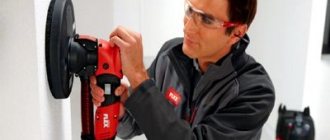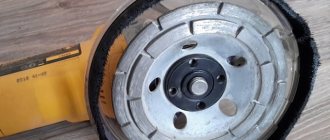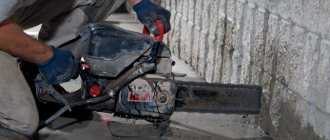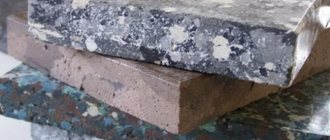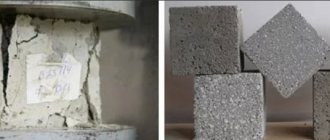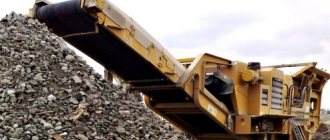Purpose and types
Concrete grinding is most often used when working with flooring. This process allows you to achieve not only an aesthetically pleasing appearance, but also creates the basis for further covering of the floor.
In addition, polished concrete becomes stronger and less susceptible to moisture, which allows it not to undergo destruction for a long period.
The appearance of the tool is associated with the invention of the electric motor. But who first invented the grinding machine is still not known for certain. According to one version, its ancestor was the German concern BOSCH, founded in 1886, which today is one of the largest manufacturers of power tools in the world. According to another assumption, the developer was AEG Powertools. AEG, also headquartered in Germany, was founded in 1883 and was considered a leader in the production of grinding equipment until the outbreak of World War II.
When used for grinding and polishing substrates, electric machines differ in their operating principle. The following types are distinguished:
- tape;
- vibration;
- eccentric;
- corner;
- straight;
- brushed
There are two ways to perform concrete grinding: wet and dry. The first method is preferable, since it does not generate dust, but wet sludge appears instead. Wet processing of the base allows you to achieve maximum smoothness, almost satin. At the same time, dry work is characterized by significant generation of large amounts of dust and requires the use of additional personal protective equipment.
The general principle of operation for all concrete grinders is to ensure mechanical contact of the abrasive material with the surface of the base being processed.
For this, a drive is used that forces this material to perform various types of movements. The tool performs the following work:
- grinding and polishing of concrete surfaces;
- removal of a worn layer with impaired characteristics;
- leveling the bases;
- improving the adhesion of surfaces by creating roughness on them.
Difference in operating principle
The most common type of device in the household segment is angle grinders (angle grinders). With their help, it is easy to not only grind, but also cut stone or concrete, even in hard-to-reach places. The design of the angle grinder is based on a rotary engine. A toothed gear is installed on its shaft, which meshes with the gears of the drive spindle. A special feature of using this type of machine is its high speed.
Vibrating and belt tools differ from other types of sanders in their simple controllability and low weight. Consumables have the lowest price.
The operation of the tools is based on the principle of reciprocating movement of the grinding attachment. The abrasive material is secured using clamps, which makes changing it convenient. This type of machine is used in the final stage for polishing concrete. Fabric-based tapes are used as attachments.
Concrete pumps
Capacity and discharge pressure
The requirements of the construction site determine what capacity a stationary concrete pump or truck-mounted concrete pump must have. It depends on the size of the site (distance and height of transportation), on the size of the individual sections to be concreted (productivity) and on the properties of the concrete being laid (cement content, consistency, grain size, etc.). A concrete pump, which is required to deliver a certain amount of concrete in a given time, must have a design that guarantees the collection of a given amount of concrete and its transportation to the place of placement. The longer the transport pipeline and the faster the concrete flows through it, the greater the supply pressure. It is easy to understand that the drive power of a pump that develops high pressure to transport concrete over a long distance will be greater than that of a plant that transports concrete only over short distances. Only pumps with the same drive power can be compared with each other.
Suction
Concrete can only be squeezed out of the pump cylinder if it has previously been filled with concrete. This filling also requires pressure. Atmospheric pressure (1 bar = 760 torr) forces the concrete into the tank, which is under low pressure. The suction piston creates a reduced pressure in the cylinder. Atmospheric pressure “squeezes” the concrete out of the bunker into the cylinder. The pressure difference between atmosphere and vacuum theoretically cannot be more than 1 bar. In the pump, under favorable conditions, it can be 0.8 bar. This means that the concrete is fed from the hopper into the cylinder with a maximum of 0.8 bar. Therefore, hard and coarse concrete mixtures are sucked in worse than thin and plastic ones. Optimal suction conditions are ensured when the suction openings have the same cross-section as the pump cylinder. The valve (gate) must be designed in such a way that the suction section remains as open as possible, without impeding the flow of concrete or changing its direction of movement. Large volumes of concrete require larger cylinders and appropriately sized suction openings. The diameters of the suction hole and cylinder determine the maximum grain size of the transported concrete. The simplest rule requires that the diameter of the suction channel be at least 3 times the diameter of the largest grain. That is, concrete with a maximum grain size of 63 mm requires a concrete pump with a feed cylinder diameter of at least 180 mm.
Mixer
Modern concrete pumps are equipped with mixers installed in bunkers. The mixer is designed to maintain concrete in a fluid state while the pump is idle, it prevents the concrete from settling and destroys structures formed near the suction openings. However, these mixers are not full-fledged concrete mixers. When the pump is turned off and mixing times are long, preparing concrete using a mixer is very problematic.
Pressure
The maximum pressure provided by a concrete pump is determined by its design. A variety of devices have been developed for different operating conditions. Truck-mounted concrete pumps usually operate with short concrete pipes corresponding to the length of the concrete distributor mast. They require a lower discharge pressure compared, for example, with stationary pumps on construction sites, which must deliver the same volume of concrete to a height of 100 m. For mobile concrete pumps (concrete pumps), as a rule, discharge pressures of up to 70 bar are sufficient, including and at high productivity. Stationary concrete pumps delivering concrete over distances of up to 1000 m or heights of up to 500 m require pressures of up to 200 bar. Such pressures place increased structural demands on all components operating under pressure, such as gate valves, hoses, gearboxes, pipelines, etc. Uninterrupted operation of the pump is only possible if all the specific requirements of a particular construction site are taken into account when selecting it. An installation that is constantly overloaded cannot operate efficiently.
| Concrete pump model | Productivity, m3/hour | Supply pressure, bar | Feeding range up/horizontally, m | Appearance | |
Piston stationary concrete pumps | |||||
| Stationary concrete pump Putzmeister P 715 - rent (Putzmeister P 718 - rent) Stationary concrete pump Putzmeister P 715 - sale (Putzmeister P 718 - sale) | 18 | 70 | 60/200 | ||
| Stationary concrete pump Putzmeister BSA 1407 D - rent Stationary concrete pump Putzmeister BSA 1407 D - sale | 71/47 | 71/106 | 100/250 | ||
| Stationary concrete pump Schwing SP 1800 D - rent Stationary concrete pump Schwing SP 1800 D - sale | 65/42 | 56/101 | 100/250 | ||
| Stationary concrete pump Putzmeister BSA 2109 HD - rent Stationary concrete pump Putzmeister BSA 2109 HD - sale | 95/57 | 91/152 | 130/350 | ||
| Stationary concrete pump Putzmeister BSA 2109 HP D - rent | 95/57 | 91/152 | 150/400 | ||
| Stationary concrete pump Schwing SP 4800 D - rent | 43-81 | 104-243 | 150/400 | ||
| Stationary concrete pump Putzmeister BSA 2110 HP D - rent Stationary concrete pump Putzmeister BSA 2110 HP D - sale | 102/70 | 150/220 | 180/400 | ||
| Stationary concrete pump Schwing SP 8800 D - rent | 63-116 | 104-243 | 300/800 | ||
| Stationary concrete pump Putzmeister 14000 HP D - rent | 102/70 | 150/220 | 350/1000 | ||
Pneumatic stationary concrete pumps | |||||
| Pneumatic concrete pump Strojstav PX 500 - rent | 8 | 6 | concrete - 30/150 mortar - 150/300 | ||
| Pneumatic concrete pump Putzmeister M 500 E - rent | 6 | 6 | concrete - 30/150 mortar - 150/300 | ||
Concrete pumps | |||||
| Concrete pump Putzmeister M 36 - IVECO chassis | 90 | 71 | 35,6/31,7 | ||
| Concrete pump Putzmeister M 42 - Mercedes chassis | 120 | 85/95 | 41,8/38,1 | ||
| Schwing SX 52 concrete pump - Mercedes chassis | 160 | 85 | 52,0/48,1 | ||
| Concrete pump CIFA K52L XRZ | 150 | 80 | 52,0/48,5 | ||
Device selection criteria
When choosing a power tool, one is primarily guided by the scale of work to be performed and its frequency. If necessary, the device can simply be rented. The main characteristics of sanders include:
- Power . This is the most important characteristic on which the performance of the device as a whole depends, as well as its continuous operation time. There is a directly proportional relationship between the weight of the tool and its power. The average power of the machines ranges from 600 W to 3 kW. For home use, a tool with a rating not exceeding 1.5 kW is sufficient. Which is about three hours of continuous work.
- Engine's type . There are devices that operate using both electricity and liquid fuel. For household use, a tool is available with a motor designed to connect to a 220 volt industrial network. Professional-looking ones can already be connected to a 380-volt network or run on gasoline. The fuel drive is ideally used in open areas, since for its smooth operation it is necessary to ensure a constant flow of air.
- Weight and dimensions . The smaller these indicators are, the more maneuverable the tool will be. These parameters are especially important when working with walls and ceilings. The average weight of a household sander is three kilograms.
- Circle diameter . The area of the grinding surface and the smoothness of the transition depend on its size. The larger it is, the faster all the work will be done, but the more unprocessed area will remain in the corners of the surface. Discs are available in diameters: 115, 125, 150, 180, 230 and 300 mm.
- Shaft diameter . The size of the spindle determines which discs the machine can work with. The most used sizes: M14 and M16.
- Speed . It is better when the rotation speed in the device can be adjusted depending on the type of work. Low rotation speed is used for rough processing, and high rotation speed for finishing.
- Accessories . The presence of additional accessories makes work more convenient and safe. The most necessary modifications include: an anti-vibration handle, a vacuum cleaner, a stabilizer and speed controller, a start blocker, smooth activation, and a water supply pump.
Last but not least, you need to pay attention to the place where you purchased the tool, as well as its manufacturer.
The likelihood of purchasing a counterfeit in large retail outlets will be very small, and you can always count on high-quality warranty and post-warranty service. And when purchasing a machine produced by a famous brand, you can be sure that the declared characteristics correspond to the real ones.
Diamond drilling of concrete: advantages and disadvantages
As we found out earlier, a hammer drill is not always able to cope with drilling a perfectly even hole of a given size. Concrete, brick, monolith are durable materials, for drilling holes in which it is optimal to use a diamond tool. Our teams have diamond drilling units at their disposal, which can be used to perform the following work:
- Without unnecessary noise, vibrations, and the formation of excessive volumes of concrete dust that can negatively affect the health of humans and animals.
- With the ability to adjust in a wide range of depth (from 1-2 mm), diameter (up to 300 mm or more) of holes.
- With confidence that for diamond drilling the price is commensurate with the expense item allocated for a specific type of work.
The quality of diamond drilling is higher than using standard methods Source pkgarantstroy
See also: Catalog of popular sites in the Moscow region for the construction of a country house
Diamond drilling of holes in concrete is a real boon for customers who want to lay main or additional utility lines quickly and efficiently, without the need to spend a lot of time eliminating the consequences of making holes using an industrial hammer drill.
Sander manufacturers
When purchasing equipment for processing concrete pavements, you need to pay attention not to the country of the manufacturer, but to his name. Due to great competition, many famous brands are moving their production facilities to China and Taiwan to reduce product costs. This does not in any way affect the quality of the finished product, since the entire production process occurs in accordance with technical standards and under control. Of the numerous manufacturers, the following companies are most popular:
- Bosch . A German corporation that produces various types and classes of household appliances and equipment. Their products are of excellent quality and ease of use. The presence of authorized service centers around the world allows you to quickly restore the operation of a failed tool.
- Makita . The price of their instrument is quite high compared to competitors, but it is fully justified by the quality. The products of the Japanese concern are durable and reliable. Under the Makita brand you can find both semi-professional and professional equipment.
- DeWALT . An American brand that introduces innovative developments into its products. The ideology of the enterprise is to provide maximum quality products at minimum cost. It produces tools for both entry-level and professional levels.
- AGP . The company has extensive experience in the design of construction equipment. She has a large number of developments and patents. All products manufactured under this brand are distinguished by powerful and high-quality engines. Each instrument undergoes pre-sale preparation and configuration, which determines its high technical characteristics. Occupies a leading position in the professional tool niche.
- Hitachi . First of all, it is known for the quality of its motors, which ensures good reliability of its products in general. High quality products are achieved through the use of the latest technologies and high quality control.
Domestic companies have also proven themselves well: Zenit, Skif-M, Interskol. Although they are inferior in quality to European brands, they are quite competitive in the household segment due to their low cost.
